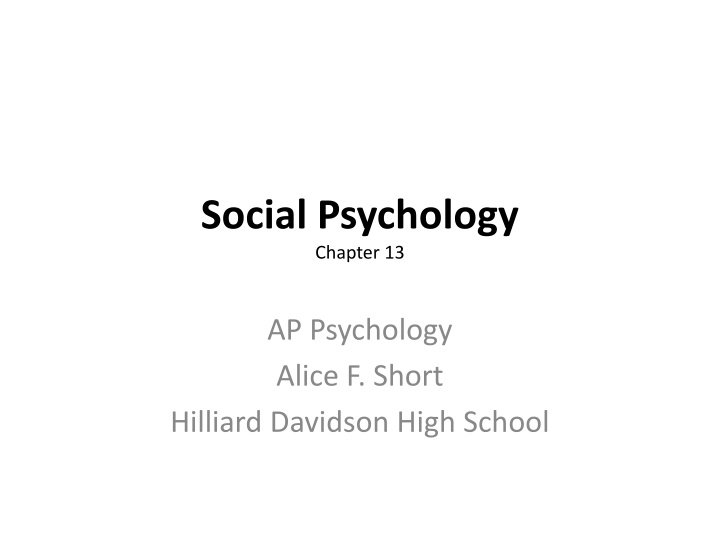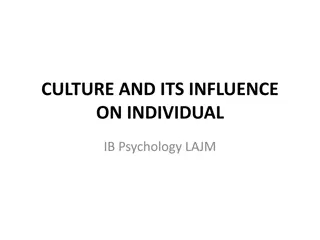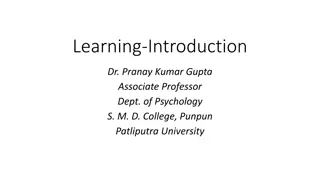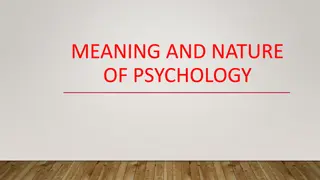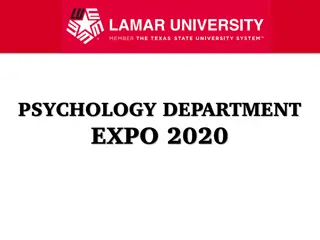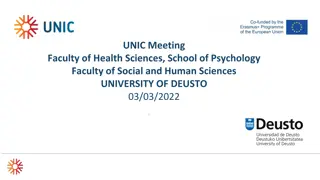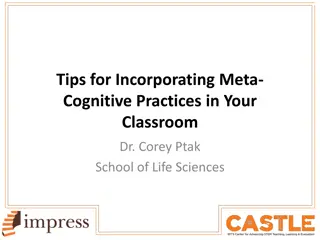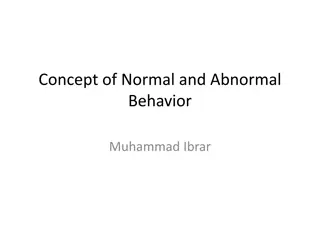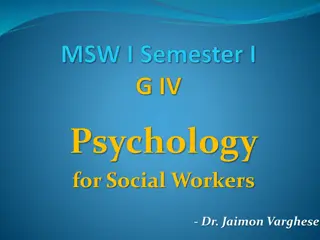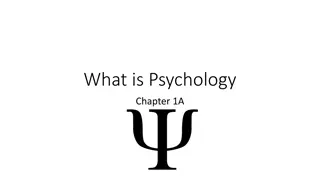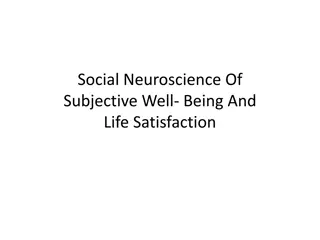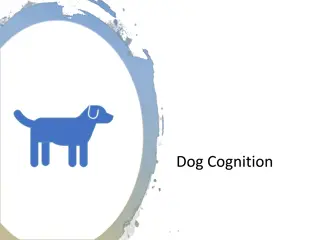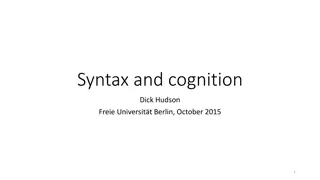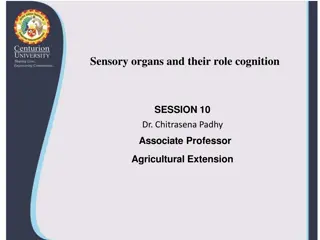Social Psychology in AP Psychology - Understanding Social Cognition and Behavior
Dive into the fascinating realm of social psychology with a focus on social cognition, behavior, influence, and relationships. Explore the intricate workings of how individuals perceive and interpret social information, form impressions, make attributions, and analyze behaviors. Uncover concepts such as person perception, stereotypes, first impressions, and attribution theory. Delve into the complexities of understanding human interactions, motivations, and responses within social contexts, shedding light on the dynamics of social influence and relationships.
Download Presentation

Please find below an Image/Link to download the presentation.
The content on the website is provided AS IS for your information and personal use only. It may not be sold, licensed, or shared on other websites without obtaining consent from the author.If you encounter any issues during the download, it is possible that the publisher has removed the file from their server.
You are allowed to download the files provided on this website for personal or commercial use, subject to the condition that they are used lawfully. All files are the property of their respective owners.
The content on the website is provided AS IS for your information and personal use only. It may not be sold, licensed, or shared on other websites without obtaining consent from the author.
E N D
Presentation Transcript
Social Psychology Chapter 13 AP Psychology Alice F. Short Hilliard Davidson High School
Chapter Preview Social Cognition Social Behavior Social Influence Intergroup Relations Close Relationships Social Psychology and Health and Wellness
Social Psychology social psychology - the study of how people think about, influence, and relate to other people social cognitions social influences social relations
Social Cognition How do people select, interpret, remember, and use social information? Person Perception physical attractiveness stereotype a generalization about a group s characteristics that does not consider any variations from one individual to another natural = cognitive processing limitations Beautiful is good stereotype self-fulfilling prophecy expectations cause individuals to act in ways that serve to make the expectations come true teacher expectations of late bloomers expectations met composite faces, symmetry, and youthfulness first impressions 100 milliseconds form first impression attribution the process by which we come to understand the cause of others behavior and form an impression of them as individuals
Social Cognition: Attribution Theory attributions - explanations for why people behave the way they do attribution theory - attempt to discover underlying causes of behavior as part of their effort to make sense of the behavior internal/external causes internal: traits and abilities external: social pressure, aspects of situation stable/unstable causes hostile or bad mood? controllable/uncontrollable causes should we hold it against you?
Social Cognition: Attribution attribution errors actor person who produces the behavior observer person who offers a causal explanation for actor s behavior observers often explain actors behaviors incorrectly fundamental attribution error overestimate the importance of internal traits underestimate the importance of external causes Zimbardo on Abu Ghraib prison TED TALKS actors often explain own behavior in terms of external causes
Social Cognition heuristics - cognitive shortcuts that speed decision making stereotypes = type of heuristic false consensus effect overestimating the degree to which everyone else thinks or acts the way we do use our outlook to predict that of others
A SHORT Time to Ponder How do politicians use the false consensus effect to their advantage?
The Self as a Social Object self-esteem the degree to which we have positive or negative feelings about ourselves positive illusions views of ourselves that are not necessarily rooted in reality self-serving bias tendency to take credit for success and deny responsibility for failure internal attributions external attributions self-objectification tendency to see oneself primarily as an object in the eyes of others DOCUMENTARY: MISSRepresentation
A SHORT Time to Ponder What s so wrong with average? (By definition, 50 percent of people will always be below average.) In what ways do you objectify yourself? Would you perform differently depending on the way you were dressed?
Social Cognition: The Self as Object stereotype threat - a self-fulfilling fear about being judged on the basis of a negative stereotype about our group living down to expectations African American males = work academically by checking box White males = worse at sports when reminded Asian women = better at math by checking box Asian box, worse by checking female box social comparison - process by which we evaluate our thoughts, feelings, behaviors, and abilities in relation to other people social comparison theory when no objective means are available to evaluate our opinions and abilities, we compare ourselves with others
A SHORT Time to Ponder What stereotype should you think about for yourself before starting the AP Psychology test, or any academic test for that matter?
Attitudes attitudes - beliefs about people, places, and ideas Can attitudes predict behavior? when attitudes are strong when attitudes are rehearsed when person has vested interest Can behavior predict attitudes? cognitive dissonance an individuals psychological discomfort (dissonance) caused by two inconsistent thoughts uneasy when behavior beliefs effort justification type of dissonance reduction, means rationalizing the amount of effort we put into something low money hazing self perception theory Daryl Bem s (1967) theory on how behaviors influence attitudes, stating that individuals make inferences about their attitudes by perceiving their behavior I do something; therefore, I must like it.
Cognitive Dissonance Theory Discomfort caused by two dissonant thoughts thoughts of ones attitude v. ones behavior Dissonance reduced by changing behaviors to match attitude changing attitudes to match behavior
Self-Perception Theory self-perception theory - individuals make inferences about their own attitudes by perceiving their own behavior, especially if their attitudes are unclear cognitive dissonance and self-perception theory explain the connection between attitudes and behavior
Persuasion 2 Essential Questions: What makes an individual decide to give up an original attitude and adopt a new one? What makes a person decide to act on an attitude that he or she has not acted on before
Persuasion 1. The Communicator (credibility) trustworthiness, expertise, attractiveness, likeability, similarity 2. Medium (television versus print) but should it? 3. The Target (age, attitude, strength) 4. Message (rational versus emotional strategy) elaboration likelihood model: central route sound, logical argument effective: ability and motivation to pay attention to the facts peripheral route non-message factors (credibility, attractiveness, emotional appeals) effective: people are not paying attention; don t want to expend mental effort
Persuasion Successful Persuasion foot-in-the-door technique small request big demand door-in-the-face technique biggest demand smaller concessionary demand reciprocity and obligation SHORT DISCUSSION: How do you use either of these techniques on your parents? Resisting Persuasion inoculation William McGuire introducing a weak version of a persuasive message and allowing them time to argue against it (like a vaccine) inoculation: Credit card companies prey on college students!
Social Behavior we behave in social ways toward the people around us two extremes of human social activity altruism (prosocial behavior) aggression
Prosocial Behavior altruism (prosocial behavior) - an unselfish interest in helping someone else random acts of kindness debate: is it possible to be completely altruistic? Ayn Rand: opposed to altruism why? egoism giving to another person to ensure reciprocity; to gain self-esteem; to present one-self as powerful, competent, or caring; or to avoid censure from ones self and others for failing to live up to society s expectations reciprocity
Prosocial Behavior explanations of altruism evolutionary promoting survival of family s genes research: humans not necessarily self-centered animals: demonstrate altruism psychological factors mood happy people = more helpful feelings of elevation (video: photo shoot) empathy a person s feelings of oneness with the emotional state of another sociocultural factors market economies more prosocial behavior (trust = requirement) investment in established religion emphasis on golden rule gender women: more helpful in nurturing situations men: more helpful in dangerous situations and when feel competent to help
Prosocial Behavior The Bystander Effect Darley and Latan (1968) individuals are less likely to help in an emergency when others are present then when the observer is alone diffusion of responsibility Media Influence listening to music with prosocial lyrics increases kindness TV shows with positive content increase prosocial behavior Lemmings video game prosocial behavior
A SHORT Time to Ponder Do you believe that human nature is more selfish or altruistic? Happy people just don t kill their husbands, they just don t. Elle Woods, Legally Blonde Do your favorite TV shows promote prosocial behavior? Should TV be required to promote prosocial behavior? Can you think of a time when altruism is linked to aggression?
Aggression aggression social behavior whose objective is to harm someone, either physically or verbally biological influences evolutionary views more likely to survive genetic basis breeding docile animals and vicious animals physical aggression more linked to genes social aggression more linked to environmental neurobiological factors limbic system - active frontal lobes of brain smaller / less functioning low levels of serotonin high levels of testosterone results = less consistent with humans than animals operational definitions of aggression external validity criticism
Aggression psychological influences aversive circumstances triggers aggression frustration the blocking of an individual s attempts to reach a goal triggers aggression frustration-aggression hypothesis frustration always leads to aggression weather, physical pain, crowding triggers aggression cognitive determinants priming (seeing a weapon prime hostile thoughts) perception of unfairness triggers aggression observational learning Bobo doll study, Bandura, Ch. 6 violence on TV violence at home
Aggression sociocultural influences cultural variations inequality (gap b/w the rich and poor) U.S. higher homicide rate compared to other developed countries greater inequality (YouTube clip) culture of honor honor killings the South
Aggression media violence television increases aggression changes attitudes towards violence violence in home = more significant violent pornography small effect on male sexual aggression increases acceptance of violence toward women rape myth the false belief that women desire coercive sex violent video games rational though is suspended and highly arousing aggressive scripts are increasingly likely to be learned CORRELATIONAL RESEARCH: more aggressive less sensitive to real-life violence more likely to engage in delinquent acts lower grades
Critical Controversy: A SHORT Time to Ponder Do you or people you know play violent video games? If so, what impact, if any, do you think this activity has on your or their thoughts and feelings? Would you allow your child to play violent video games? Why or why not? What do you think policymakers should do with regard to the controversy over the effects of playing video games?
Aggression reducing aggression decrease rewards lessen exposure encourage empathy monitor adolescents activity
Social Influence: Conformity conformity a change in a person s behavior to coincide more closely with a group standard can lead to enhanced cooperation among group members Asch s Experiment (1951) factors that contribute to conformity informational social influence the influence other people have on us because we want to be right normative social influence the influence others have on us because we want them to like us volunteer participant conformed to incorrect answers 35% of time VIDEO Clip: demonstrates power of conformity (breaking social norms) cognitive neuroscience fMRI images - when women found others disagreed, they responded as mistakes
Social Influence: Conformity Which line is the same length? CHALLENGE: As a group, try to convince someone of something obviously incorrect
Social Influence: Obedience obedience behavior the complies with the explicit demands of the individual in authority obedient: authority figure demands we do Stanley Milgram s Experiments (1965, 1974) factors that contribute to disobedience disobedient models authority figure not legitimate or not close by victim made to seem more human ethical concerns regarding Milgram deception VIDEO: TED Talks (may leave the room very graphic)
Social Influence: Obedience How far do you think you would go?
Group Influence Deindividuation erosion of personal identity and responsibility anonymity example: KKK group, darkness, wearing white Social Contagion imitative behavior spread of behavior, emotions, and ideas examples: social fads, the popularity of dog breeds, the spread of unhealthy behaviors (smoking and drinking in adolescents), symptoms of eating disorders among young women experiment: go someplace quiet and start coughing observations: misbehaviors in school (talking, packing up early, etc.) Group Performance social facilitation: arousal with well-learned tasks social loafing: reduced accountability
Group Decision Making Risky Shift group decisions are riskier than average individual decisions Group Polarization discussion strengthens the individual s position
Group Decision Making: Groupthink groupthink group harmony valued over right or correct impaired decision making and avoidance of realistic appraisal symptoms of groupthink overestimating the power and morality of one s group close-mindedness lack of willingness to hear all sides of an argument pressure for uniformity get with the program dissent meets with very strong disapproval avoiding groupthink avoid isolation allow the airing of all sides of an argument have an impartial leader include outside experts in the debate encourage group members who are strongly identified with the group to speak out in defense
Group Decision Making: Majority-Minority Influence Majority-Minority Influence majority: normative and informational pressure informational greater opportunity to share normative set group norms those who do not go along may be ignored or given the boot minority: informational pressure cannot win with normative pressure must use informational pressure consistency and confidence = key must win over majority members
A SHORT Challenge Can you think of a minority position that you support? Create a cogent argument in support. Then consistently and confidently defend it.
Intergroup Relations Group Identity us versus them Social Identity define ourselves in terms of group membership assumes commonalities
Intergroup Relations Henry Tajfel s Social Identity Theory our social identities are a crucial part of our self-image and a valuable source of positive feelings about ourselves in-groups versus out-groups in-group a group that has special value in comparison with other groups out-group focus more on the differences between the groups than on their similarities Tajfel s Reseach (1978) dot estimation (over or under) to create arbitrary groups asked to award money to other participants awarded money to members of their own group more conclusion: we favor the members of in-groups based on trivial differences... Ethnocentrism favoring one s own group over other groups out-groups not just different, but worse/inferior/less than
A SHORT Time to Ponder: Tajfel s Reseach (1978) How has this concept been used around the world and through history to oppress people? Rwanda Slavery in the United States
Prejudice an unjustified negative attitude toward a group and its members explicit versus implicit racism explicit racism a persons conscious and openly shared attitude, which might be measured using a questionaire implicit racism attitudes that exist on a deeper, hidden level must be measure with a method that does not require awareness Implicit Associations Test (IAT) a computerized survey that assesses the ease with which a person can associate a Black or White person with good things THE DOLL TEST: VIDEO!! If you find it the original vide, I will drop the lowest grade from every person in your class period for the fourth quarter AND I will buy your class donuts and coffee from the place of your choice explanations for prejudice competition between groups cultural learning Dream Deferred, post cards, and kids learning racism motivation to enhance self-esteem limitations in cognitive processes
Prejudice ethnic cleansing U.S. racial prejudice black names video Freakonomics video clip white names 50% more likely to get an interview Are you racist? 88% of Americans say no
Stereotyping and Prejudice stereotype - a generalization about a group discrimination - unjustified negative or harmful action Civil Rights Act of 1964 (revised 1991) unlawful to deny someone employment on the basis of gender or ethnicity video: actresses / typecasting
Stereotyping and Prejudice How can relationships between ethnic groups be improved? contact does not lead to tolerance / warm relations Gordon Allport (1954) think that they are equal status feel that an authority figure sanctions the positive relationships believe that friendship might emerge from the interaction engage in cooperative tasks in which everyone hast to contribute
Stereotyping and Prejudice Improving Interethnic Relations Contact Only is Not Effect Works best if groups: think they are of equal status feel an authority figure approves positive relations anticipate emergent friendship engage in cooperative tasks task-oriented cooperation: Sherif s robbers cave study Aronson s jigsaw classroom
Stereotyping and Prejudice task-oriented cooperation: Muzafer Sherif s robbers cave study organized groups of 11-year-old boys into Rattlers and the Eagles in a summer camp called Robbers Cave competed in baseball, touch football, tug-of-war relations became ugly brought together to complete tasks repairing camp s only water supply system, pooling money to rent movie shows how competitive and cooperative activities changes perceptions of the out-group Eliot Aronson s jigsaw classroom real-world application: violence and ethnic tensions in desegregated schools between African Americans, Mexican Americans and Whites jigsaw classroom all students have to pull together to get the big picture each group contains similar ethnic and ability level associated with increased self-esteem, better academic performance, friendships among classmates, and improved interethnic perceptions
